Related Research Articles

The Zhuang are a Tai-speaking ethnic group who mostly live in the Guangxi Zhuang Autonomous Region in Southern China. Some also live in the Yunnan, Guangdong, Guizhou, and Hunan provinces. They form one of the 56 ethnic groups officially recognized by the People's Republic of China. With the Bouyei, Nùng, Tày, and other Northern Tai speakers, they are sometimes known as the Rau or Rao people. Their population, estimated at 18 million people, makes them the largest minority in China, followed by the Hui and Manchu.

The Gulf of Tonkin is a gulf at the northwestern portion of the South China Sea, located off the coasts of Tonkin and South China. It has a total surface area of 126,250 km2 (48,750 sq mi). It is defined in the west and northwest by the northern coastline of Vietnam down to the Hòn La Island, in the north by China's Guangxi Zhuang Autonomous Region, and to the east by the Leizhou Peninsula and Hainan Island.

The Zhuang languages are any of more than a dozen Tai languages spoken by the Zhuang people of Southern China in the province of Guangxi and adjacent parts of Yunnan and Guangdong. The Zhuang languages do not form a monophyletic linguistic unit, as northern and southern Zhuang languages are more closely related to other Tai languages than to each other. Northern Zhuang languages form a dialect continuum with Northern Tai varieties across the provincial border in Guizhou, which are designated as Bouyei, whereas Southern Zhuang languages form another dialect continuum with Central Tai varieties such as Nung, Tay and Caolan in Vietnam. Standard Zhuang is based on the Northern Zhuang dialect of Wuming.
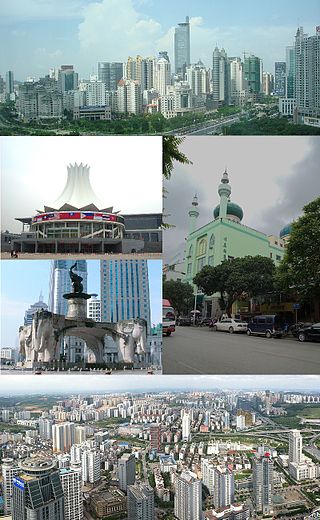
Nanning is the capital and largest city by population of the Guangxi Zhuang Autonomous Region in Southern China. It is known as the "Green City" because of its abundance of lush subtropical foliage. Located in the South of Guangxi, Nanning is surrounded by a hilly basin, with a warm, monsoon-influenced humid subtropical climate.
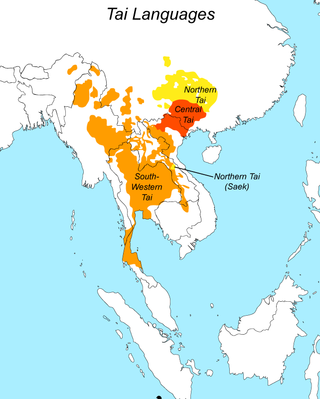
The Tai or Zhuang–Tai languages are a branch of the Kra–Dai language family. The Tai languages include the most widely spoken of the Tai–Kadai languages, including Standard Thai or Siamese, the national language of Thailand; Lao or Laotian, the national language of Laos; Myanmar's Shan language; and Zhuang, a major language in the Southwestern China's Guangxi Zhuang Autonomous Region, spoken by the Zhuang (壯) people, the largest minority ethnic group in China, with a population of 15.55 million, living mainly in Guangxi, the rest scattered across Yunnan, Guangdong, Guizhou and Hunan provinces.

Wuzhou, formerly Ngchow, is a prefecture-level city in the east of Guangxi Zhuang Autonomous Region, People's Republic of China.
Longtan Dam is a large roller-compacted concrete (RCC) gravity dam on the Hongshui River in Tian'e County of the Guangxi Zhuang Autonomous Region, China, a tributary of the Xi River and the Pearl River. The dam is 216.2 metres (709.3 ft) high and 849 m (2,785 ft) long; it is the tallest of its type in the world. The dam is intended for hydroelectric power production, flood control and navigation. The dam contains seven surface spillways, two bottom outlets and an underground power station. The Longtan ship lift, part of the dam complex, will be the tallest ship lift system in the world.

Laibin is a prefecture-level city in the central part of the Guangxi Zhuang Autonomous Region, China.
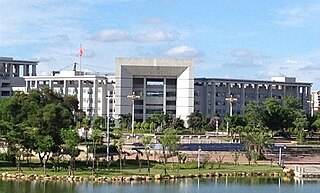
Chongzuo is a prefecture-level city in the south of Guangxi Zhuang Autonomous Region near the Sino-Vietnamese border. It is home to one of China's largest Zhuang populations.
A macrolanguage is a book-keeping mechanism for the ISO 639 international standard for language codes. Macrolanguages are established to assist mapping between different sets of ISO language codes. Specifically, there may be a many-to-one correspondence between ISO 639-3, intended to identify all the thousands of languages of the world, and either of two other sets, ISO 639-1, established to identify languages in computer systems, and ISO 639-2, which encodes a few hundred languages for library cataloguing and bibliographic purposes. When such many-to-one ISO 639-2 codes are included in an ISO 639-3 context, they are called "macrolanguages" to distinguish them from the corresponding individual languages of ISO 639-3. According to the ISO,
Some existing code elements in ISO 639-2, and the corresponding code elements in ISO 639-1, are designated in those parts of ISO 639 as individual language code elements, yet are in a one-to-many relationship with individual language code elements in [ISO 639-3]. For purposes of [ISO 639-3], they are considered to be macrolanguage code elements.

Yilong is a county in the northeast of Sichuan Province, China. It is under the administration of the prefecture-level city of Nanchong. Zhu De's Former Residence is located here. Zhu De was general and one of the pioneers of the Chinese Communist Party.
Youjiang District is the municipal district of Baise, Guangxi, China, named after the Youjiang River which runs through the middle of the district.

Fusui County is a county in the southwest of Guangxi, China. It is the easternmost county-level division of the prefecture-level city of Chongzuo.
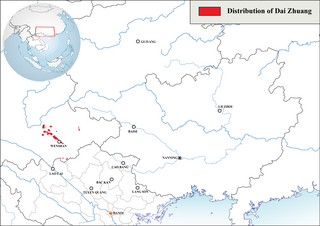
Dai Zhuang or Thu Lao is a Tai language spoken in Yunnan, China and northern Vietnam. In China is it spoken in Yanshan, Wenshan, Maguan, Malipo, Guangnan counties of Wenshan Prefecture. It is also spoken in Honghe Prefecture. The largest concentrations are in Wenshan and Yanshan counties.

Nong Zhuang is a Tai language spoken mainly in Wenshan Prefecture, Yunnan, China. In Wenshan Prefecture, it is spoken in Yanshan, Guangnan, Wenshan, Maguan, Funing, Xichou, and Malipo counties, and also in Honghe Prefecture and Vietnam. The heaviest concentrations relative to other Zhuang groups are in Xichou and Malipo counties.

The Northern Tai languages are an established branch of the Tai languages of Southeast Asia. They include the northern Zhuang languages and Bouyei of China, Tai Mène of Laos and Yoy of Thailand.

Standard Zhuang is the official standardized form of the Zhuang languages, which are a branch of the Northern Tai languages. Its pronunciation is based on that of the Yongbei Zhuang dialect of Shuangqiao Town in Wuming District, Guangxi with some influence from Fuliang, also in Wuming District, while its vocabulary is based mainly on northern dialects. The official standard covers both spoken and written Zhuang. It is the national standard of the Zhuang languages, though in Yunnan a local standard is used.

The You River, also known as the Youjiang River, is a river of Guangxi, China. It rises in eastern Yunnan and joins the Zuo River near Nanning to form the Yong River. These rivers form part of the Pearl River system, which flows into the South China Sea near Guangzhou.
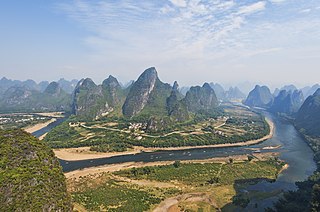
Guangxi, officially the Guangxi Zhuang Autonomous Region (GZAR), is an autonomous region of the People's Republic of China, located in South China and bordering Vietnam and the Gulf of Tonkin. Formerly a province, Guangxi became an autonomous region in 1958. Its current capital is Nanning.
Liushuquan is a town in Fengnan County, Tangshan, Hebei near the coast of the Bo Sea to the immediate northeast of the Port of Tianjin and the immediate northwest of the Port of Tangshan Caofeidian (曹妃甸港). Liushuquan Town is named after a village founded in the northern part of the town in 1662. Liushuquan has a reputation as a "land of fish and rice where you can easily find a Holocentridae fish or a Tianjin Purple Crab".
References
- ↑ Eastern Hongshuihe Zhuang at Ethnologue (18th ed., 2015) (subscription required)